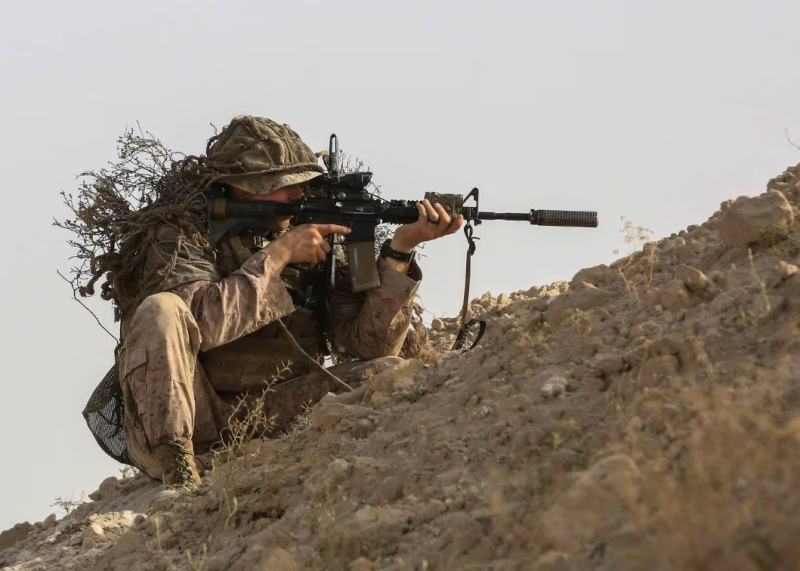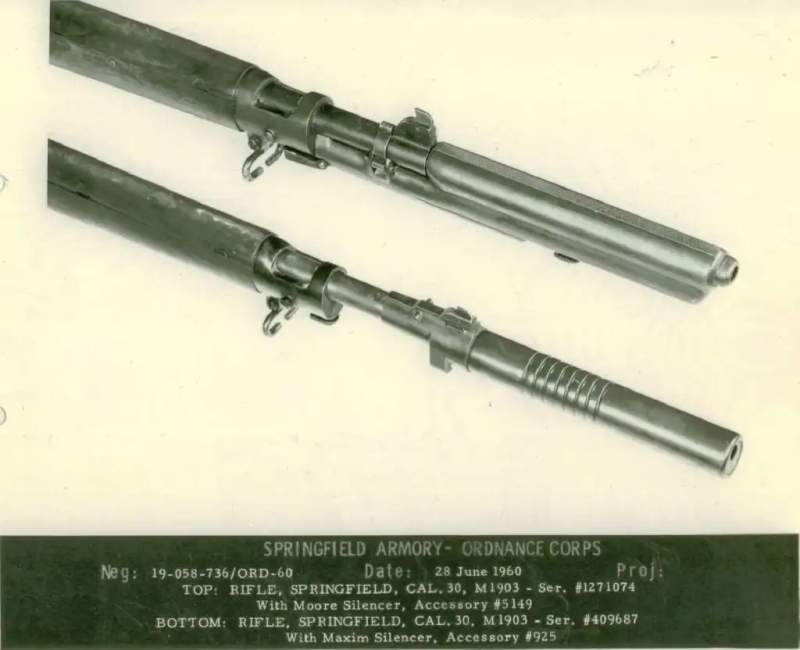The US Military’s Suppressed Weapons
William Lawson
The US Army and Marine Corps are making suppressors standard issue for their front-line infantrymen. The Marines began the process in 2016, field-testing suppressed M-4 carbines and M-27 Infantry Automatic Rifles.
2021 saw suppressors issued across the board, with the goal of protecting shooters’ hearing, facilitating battlefield voice communication, and reducing each man’s noise and light signature.

The Army notably included suppressors on its new Next Generation Squad Weapon program based on the Sig MCX Spear. The XM-7 rifle and the XM-250 light machine gun will be equipped with factory suppressors. Once complete, these weapon deployments will mark the first time that a modern military has been fully equipped with suppressed weapons.
But the US military’s interest in suppressors dates to the early twentieth century. Full-scale adoption took over a century and was full of starts and stops. Technology, cost, and mission compatibility all contributed to the suppressor’s slow journey to acceptance.
Let’s begin with the first viable suppressor: the Maxim Silencer.

Hiram Percy Maxim
Hiram Percy Maxim’s father, Sir Hiram Maxim, invented the Maxim machine gun.
The younger Maxim, an American, was involved in the firearms business, but founded his own company making automobile parts. His thoughts quickly turned to muffling the loud internal combustion engines, and he patented several muffler designs.
His firearms background led Maxim to apply those principles to firearms.
Maxim claimed to have gotten the idea for his silencer, as he called it, while taking a bath. He noticed the water draining from the bathtub formed a vortex. He wondered whether the energy released by a fired ammunition cartridge could be redirected into such a vortex to reduce its energy, thus reducing its noise signature.
Maxim’s revelation resulted in a series of successful suppressor designs, especially the Model 1910, marketed by the Maxim Silent Firearms Company, later shortened to the Maxim Silencer Company.

The Maxim Silencer was a successful commercial product, prompting its inventor to cast an eye toward the US Army’s M-1903 Springfield rifle.
The Army Ordnance Corps tested a Maxim Silencer in 1909, reporting that it reduced the rifle’s noise by 66% and its recoil by 67%. Maxim geared his Model 1912, and improved Model 15 toward the ’03 Springfield, naming the Model 15 the “Government Silencer.”
Maxim promoted his suppressors as being perfect for scouts and snipers, for obvious reasons, but also for trainees.
Large numbers of city-bred recruits had no firearms experience, and sometimes shied away from the Springfield rifle’s powerful report and recoil. Maxim believed that reducing the rifle’s noise and kick would make it less intimidating and allow recruits to master it more easily.
The Army Goes Suppressed… Sort Of
The Army ordered Maxim’s suppressors for testing, along with those of a competitor, Robert A. Moore, also called the 1912 Silencer.
Moore’s suppressor differed from Maxim’s by using a large expansion chamber instead of ports. The Army approved both for use, but large contracts were not forthcoming.

Little is known of the service performed by suppressed 1903 Springfields, but a silencer-equipped sniper squad accompanied General John J. Pershing’s 1916 punitive expedition against Mexican bandit Pancho Villa. No record of that squad’s operations is known to exist.
The First World War saw British and German snipers field Maxim suppressors.
Some American troops took suppressed rifles to France in 1918, but there is no indication they were used in combat. The Army ordered 9,100 suppressed sniper rifles in 1917-1918, but the war ended before the order was fulfilled, and no one knows how many were produced.
The rifles do not seem to have been deployed and many were sold through the Civilian Marksmanship Program, while others went to the National Guard as training rifles.
Special Operations in World War II
The Army made little to no effort to equip soldiers with suppressors for World War II. The sheer scale of military mobilization to fight history’s largest war likely precluded such indulgences. One wonders if the 1934 National Firearms Act’s stigmatizing of suppressors affected certain decisions as well.
But the Second World War was total war by every definition. Its existential nature prompted governments to employ every means necessary to win, even those the military establishment considered “ungentlemanly.”
Great Britain first adopted sabotage as a sanctioned military endeavor out of necessity. The British expected an imminent German invasion in the summer of 1940 — an invasion they were ill-equipped to repel. Winston Churchill established pre-positioned guerilla units along his country’s southeastern coast to harry the Germans, whose successful landing was all but conceded.
Those units’ services were thankfully never required. But they, and their controlling headquarters, formed the nucleus of the Special Operations Executive (SOE).
The SOE organized and ran saboteurs and guerilla fighters throughout occupied Europe. Such operatives needed to kill sentries, guard dogs, and occasional assassination targets on the quiet. Special pistols, such as the integrally suppressed Welrod became common tools of the trade, as did regular suppressed pistols and STEN submachine guns.

The Welrod is a simple design with a single stack detachable magazine that doubles as the grip. The manual bolt action cocking mechanism eliminates the sound caused by a cycling action, while also offering an 8-round capacity. It was chambered in .32 ACP and later in 9mm Parabellum.
The Welrod was easily concealed since it resembled a bicycle pump when the magazine was removed. The weapon’s range was limited, but it was effective in its assigned role. The Welrod’s plans are still classified, and it was used by the British SAS in the 1982 Falklands War and the 1991 invasion of Kuwait.
The United States patterned its own Office of Strategic Services (OSS) on the British model. The OSS trained at SOE facilities and adopted many of its specialty weapons, including the Welrod and STEN. Suppressed American M-3 Grease Guns later joined the fray. OSS and SOE teams operated in every theater of war, harassing Axis formations and personnel, and blowing up vital infrastructure.

Suppressed Weapons in Vietnam
The American military relied heavily on special operations units during the Vietnam War. Army LRRPs and Special Forces, Navy SEALS, and Marine Recon units were fertile testing grounds for stealthy new weapons.
Early operations employed the suppressed Grease Guns, STENs, and even a few Welrods left over from World War II. But most of those weapons had seen better days and were never meant to be multi-generational platforms.

Most of the innovative weaponry flowed through the Military Assistance Command, Vietnam – Studies and Observations Group (MACV-SOG). “Studies and Observations Group” sounds rather benign, but SOG controlled all the US special ops activity in Vietnam, Laos, and Cambodia.
Elite parachute recon troops carried suppressed FN-produced UZI submachine guns and Walther PPK pistols. The UZIs provided compact firepower, while the PPKs allowed suppressed actions against sentries and animals. Foreign-made weapons were often necessary to provide deniability in areas US assets weren’t technically allowed to operate.
Other suppressed weapons included the integrally suppressed version of the Swedish “K” submachine gun, which was six inches longer than the original and a bit barrel heavy. The added weight, however, helped its accuracy.
The Grease Gun, despite its age, remained popular thanks to its controllable fire rate, which made single shots possible. The suppressed Grease Gun was also fairly accurate since the suppressor made it three pounds heavier.

The Sionics Silent Sniper was perhaps SOG’s most innovative suppressed weapon. It was an M-1 Carbine converted to a manual straight pull action and chambered in 9mm Parabellum. Like the Welrod pistol, the manual action eliminated the cycling action noise while still allowing follow-up shots. The specially made barrel was the suppressor, offering exceptional performance. The Sionics rifle was probably SOG’s quietest long gun.
SOG also employed suppressed M-14 and M-16 rifles, but lacked subsonic ammunition, so their utility was limited. Some special ops guys reportedly made their own subsonic rounds with mixed results. But some snipers made good use of the M-14-based XM-21 rifle with a suppressor, especially at longer ranges.
SOG units employed suppressed pistols, like the PPK, but perhaps the most popular was the High Standard H-D semi-automatic pistol, another World War II design.
The H-D was chambered in .22 Long Rifle, and its 7.75-inch suppressor reduced the noise level by 90%, while completely eliminating any muzzle flash. Like the other pistols, the H-D was used to take out sentries and guard dogs, but with the added benefit of lighter ammunition.

Despite its popularity, the H-D was an aging design. The Army drew its replacement from the civilian market. The Ruger MKI pistol was a proven, accurate weapon beloved of American shooters.
The Army adapted the MKI with an integral suppressor. The new suppressor mimicked the bull barrel version of the MKI pistol, making it all but indistinguishable from its civilian counterpart. Designated the MAC MKI, the Ruger saw service with SOG teams, as well as the CIA and DEA.
Finally, the SEAL teams operating in the Mekong Delta acquired specially modified Smith & Wesson Model 39 pistols with MK-3 suppressors. The weapon was designated the MK-22, but the SEALS called them “Hush Puppies,” because they were most often used against barking dogs or loud ducks who might give them away.

Tunnel Rats
Suppressed pistols also factored in non-SOG operations. The Viet Cong operated from vast and intricate tunnel systems, requiring US and South Vietnamese personnel to go in after them. These hardy soldiers were known as “Tunnel Rats.” Their job was to penetrate these underground warrens alone, with only a flashlight and a pistol.
Firing a pistol in the enclosed space was especially damaging to the men’s hearing, and the echoes could disorient them. The muzzle flash could also blind them in key moments. The Army responded by providing suppressed .22 caliber pistols, but they also commissioned a new type of weapon from the AAI Corporation.

The new weapons were built around the “piston cartridge,” which featured a sealed case and a propellant-driven piston to fire the shotgun pellet-like projectiles. It was completely silent, other than the hammer falling on the firing pin.
AAI developed special .38 and .44 caliber revolvers to fire the new round. Unfortunately, the pellets lacked the velocity to reliably dispatch an enemy soldier, with reports indicating that some were shot several times. The project was eventually dropped. But the Army did supply some specially altered revolvers capable of taking suppressors.

Modern Suppressed Weapons
Special operations units continued employing suppressors after Vietnam. The SEALS replaced their Hush Puppies with H&K P9S pistols equipped with Qual-A-Tech suppressors.
A bit later, the new Special Operations Command wanted something different from the then-new Beretta M-9 in the mid-1980s. They contracted with H&K for the .45 caliber M-23, which is still in service.
But the 21st century’s second decade brought suppressed firearms out of the shadows and into the mainstream.
Better, more affordable technology means suppressors can be fielded more broadly. Older suppressors were difficult, or even impossible to clean. They were often seen as throwaway items once their performance degraded. Military budgets and logistical systems can’t support that on a force-wide basis.

Maintenance capability has improved, along with scalable production capabilities.
The US military’s relative size also plays a factor. The days of fielding millions of combat troops are long gone, hopefully for good. Today’s smaller professional force lends itself to specialized equipment far better than the mass conscript armies of the past.
The modern American soldier or Marine’s equipment is light years beyond what it was even 25 years ago. It was time that suppressed weapons joined that equipment panoply, making US combat troops more capable than ever.








